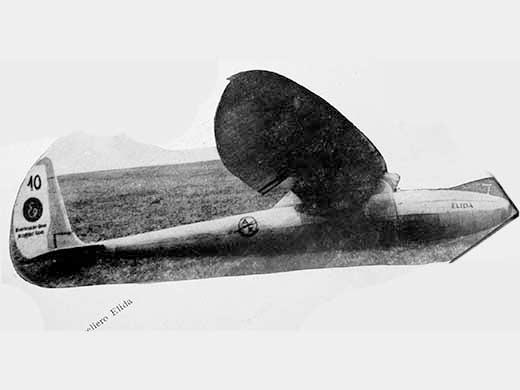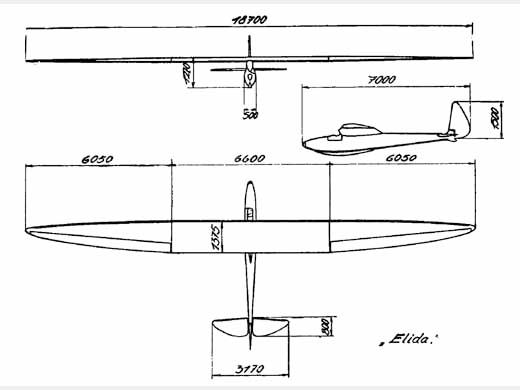| Type | Single seat high performance glider |
| Dimensions | Length 7 m , height 1,21 m , span 18,7 m , wing area 20 m2 , aspec rai 17,5, Göingen 549 |
| Weights | Empty 186 kg, loaded , max. take off weight 256 kg |
| Performance | Max.. speed , min sink 0,65 m/sec |
| Type | Werk.Nr | Registration | History |
| To participate in the Rhön contest in 1929, the firm Kegel Flugzeugbau had built the high-performance glider Elida, for the Niederhessischen Vereins für Luftfahrt e. V. (NVFL) [Lower Hessian Aeronautical Union], as well as the two-seater Herkules. But the performances were not at the rendezvous during this competition. |
The glider "Elida" is of the cantilever wing type, with a large aspect-ratio and a thin wing-section. The wing is in the usual manner built in three sections, with a rectangular middle portion and strongly tapered elliptical outer portions. The internal construction differs from the ordinary type of design, in order to attain greater stiffness of the wing, with its narrow thickness in proportion to span. The main spar, situated at the highest point of the wing-section, is almost square in the inner portion of the wing, and is stiffened by means of three strips of wood, thus forming in effect two box spars placed side by side. Behind the main spar a light
additional spar is situated at about f of the way along the wing-chord. As far as this additional spar the wing is covered on both sides with plywood. As a result of this method of construction the wing naturally became somewhat heavy, so that the gain expected from the unsupported type of wing with good aspect-ratio did not come to fulfilment. The specific wing weight of 6.9 kg. per sq. metre is as high as that of the "Kakadu."
The body, of egg-shaped section, bears some resemblance to that of the "Wien." The cross-section however is smaller and the nose more slender. The weight of the body is proportionately light, so that the great weight of the wiiiir is to some extent compensated for. The attachment and the form of the empennage conforms to the "Professor" type of construction, but the very short length of the rudder attachment appears to be rather too weak. The aircraft was disappointing in its flying performance, when one considers that, with an aspect-ratio of 1 to 17.5 and a wing-loading of 12.8 kg. per sq. m., its rate of descent must have been less than that of most of the other machines.
Evidently its controllability was prejudiced by the heavy wing and the consequent moment of inertia about the vertical and longtitudinal axes. On the other hand it might be beneficial with such a good aspect-ratio to arch the camber of the middle portion of the wing more strongly.
additional spar is situated at about f of the way along the wing-chord. As far as this additional spar the wing is covered on both sides with plywood. As a result of this method of construction the wing naturally became somewhat heavy, so that the gain expected from the unsupported type of wing with good aspect-ratio did not come to fulfilment. The specific wing weight of 6.9 kg. per sq. metre is as high as that of the "Kakadu."
The body, of egg-shaped section, bears some resemblance to that of the "Wien." The cross-section however is smaller and the nose more slender. The weight of the body is proportionately light, so that the great weight of the wiiiir is to some extent compensated for. The attachment and the form of the empennage conforms to the "Professor" type of construction, but the very short length of the rudder attachment appears to be rather too weak. The aircraft was disappointing in its flying performance, when one considers that, with an aspect-ratio of 1 to 17.5 and a wing-loading of 12.8 kg. per sq. m., its rate of descent must have been less than that of most of the other machines.
Evidently its controllability was prejudiced by the heavy wing and the consequent moment of inertia about the vertical and longtitudinal axes. On the other hand it might be beneficial with such a good aspect-ratio to arch the camber of the middle portion of the wing more strongly.









